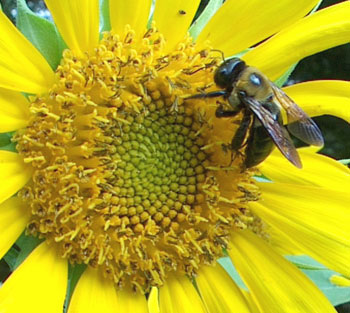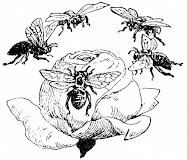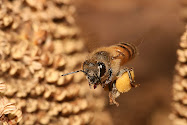
A special G R A C I A S column going out to all our dads . . .
Father’s Day Weekend :: June 19, 2010
Girls, Math & Science Partnership (GMSP) Explores Beekeeping with Burgh Bees
On June 19, Burgh Bees hosted a group of young women and their parents as part of the Carnegie Science Center’s Girls, Math & Science Partnership’s "Tour Your Future" program, held at Joe Zgurzynski's Country Barn Farm in O'Hara Township. The program was coordinated by Athena Aardweg, Weekend Program Manager of the GMSP, an innovative Science Center program for girls age 11-17 (read more about it below). The Burgh Bees team included Joe, Jennie Wood, Mary Anne Watson, Joan Guerin, Eva Barinas, and Linda Rathburn. After gathering near the barn and donning veils and gloves, the dads and daughters trooped up the hill to Joe's hives for a first-hand look and lecture on beekeeping basics, safety, and apiary etiquette. Jennie, Joe, Athena, Joan, and Eva fielded questions and then moved the group back to the barn for a closer look at the demo hive and a lesson in bee biology with Mary Anne. Everyone had a chance to get up close and personal with the bees - under glass in the demo hive and under glass at the microscope - and to take a break with several types of seasonal honey and a long cold drink of water. Beekeeping is hot, hard work in the summertime, and we hope that our guests at Saturday's "Tour Your Future" event left with a better understanding - and appreciation - of our stewardship of the fascinating, indispensable - and endangered - Apis mellifera.
Eva Barinas: “It was so exciting to see how interested everyone was despite some hesitation about being so close to honeybees. Once we did gather to get a closer look, fear evaporated and curiosity took over.”
Joan Guerin: “I imagined myself at that age learning about beekeeping and I think it would have been a great influence on me, whether I adopted it right away or not. I was so heartened by the parents who made the effort to expose their daughters to such interesting and unusual possibilities!”
Linda Rathburn: “I couldn’t help remembering that when I was their age – about 50 years ago :-) - I wanted to be a farmer when I grew up. But we weren’t encouraged – as girls – to be farmers. Today’s young women really have no limitations, and so my advice would be: try things on. Turn in the direction of what makes you happy – of what’s interesting and mysterious – and you’ll find a good fit.”
Like to know more about the Carnegie Science Center’s Girls, Math & Science Partnership? Log on to http://www.braincake.org/ and read more about it. Here’s the story from the website:
The Girls, Math & Science Partnership's mission is to engage, educate, and embrace girls as architects of change. Working with girls age 11 - 17 and their parents, teachers, and mentors, we draw organizations, stakeholders, and communities together in an effort to ensure that girls succeed in math and science.
If this is your first BrainCake experience, enjoy! BrainCake is one of many programs we have at the Girls, Math & Science Partnership. We are proud to have a Web site that reaches girls from around the globe who are interested in changing the world with math and science!
For many of you, you've been to BrainCake many times, or experienced one of our programs or events. You view this site as a resource - a resource for yourself, your daughter, a student in your classroom, or someone you mentor. The Girls, Math & Science Partnership is exactly that - an innovative, compelling, high-quality resource for education, information, research and advocacy on gender equality in the sciences.
We're here to help girls be confident, solve problems, and think independently. We engage girls in current science, helping them understand its relevance to their life today. We create and link girls to programs that educate and prepare them to understand and use science in their everyday lives. And, we embrace girls as architects of change - envisioning, planning, organizing, shaping, and building a better world - with math and science as their tools.
We know girls can change the world. We're just a great resource to help.


L to R: Linda's dad, Ken Mastron; Mary Anne's dad, Clarence Ungerman; Mary Anne Watson
Girls, Math & Science Partnership (GMSP) Explores Beekeeping with Burgh Bees
On June 19, Burgh Bees hosted a group of young women and their parents as part of the Carnegie Science Center’s Girls, Math & Science Partnership’s "Tour Your Future" program, held at Joe Zgurzynski's Country Barn Farm in O'Hara Township. The program was coordinated by Athena Aardweg, Weekend Program Manager of the GMSP, an innovative Science Center program for girls age 11-17 (read more about it below). The Burgh Bees team included Joe, Jennie Wood, Mary Anne Watson, Joan Guerin, Eva Barinas, and Linda Rathburn. After gathering near the barn and donning veils and gloves, the dads and daughters trooped up the hill to Joe's hives for a first-hand look and lecture on beekeeping basics, safety, and apiary etiquette. Jennie, Joe, Athena, Joan, and Eva fielded questions and then moved the group back to the barn for a closer look at the demo hive and a lesson in bee biology with Mary Anne. Everyone had a chance to get up close and personal with the bees - under glass in the demo hive and under glass at the microscope - and to take a break with several types of seasonal honey and a long cold drink of water. Beekeeping is hot, hard work in the summertime, and we hope that our guests at Saturday's "Tour Your Future" event left with a better understanding - and appreciation - of our stewardship of the fascinating, indispensable - and endangered - Apis mellifera.
Eva Barinas: “It was so exciting to see how interested everyone was despite some hesitation about being so close to honeybees. Once we did gather to get a closer look, fear evaporated and curiosity took over.”
Joan Guerin: “I imagined myself at that age learning about beekeeping and I think it would have been a great influence on me, whether I adopted it right away or not. I was so heartened by the parents who made the effort to expose their daughters to such interesting and unusual possibilities!”
Linda Rathburn: “I couldn’t help remembering that when I was their age – about 50 years ago :-) - I wanted to be a farmer when I grew up. But we weren’t encouraged – as girls – to be farmers. Today’s young women really have no limitations, and so my advice would be: try things on. Turn in the direction of what makes you happy – of what’s interesting and mysterious – and you’ll find a good fit.”
Like to know more about the Carnegie Science Center’s Girls, Math & Science Partnership? Log on to http://www.braincake.org/ and read more about it. Here’s the story from the website:
The Girls, Math & Science Partnership's mission is to engage, educate, and embrace girls as architects of change. Working with girls age 11 - 17 and their parents, teachers, and mentors, we draw organizations, stakeholders, and communities together in an effort to ensure that girls succeed in math and science.
If this is your first BrainCake experience, enjoy! BrainCake is one of many programs we have at the Girls, Math & Science Partnership. We are proud to have a Web site that reaches girls from around the globe who are interested in changing the world with math and science!
For many of you, you've been to BrainCake many times, or experienced one of our programs or events. You view this site as a resource - a resource for yourself, your daughter, a student in your classroom, or someone you mentor. The Girls, Math & Science Partnership is exactly that - an innovative, compelling, high-quality resource for education, information, research and advocacy on gender equality in the sciences.
We're here to help girls be confident, solve problems, and think independently. We engage girls in current science, helping them understand its relevance to their life today. We create and link girls to programs that educate and prepare them to understand and use science in their everyday lives. And, we embrace girls as architects of change - envisioning, planning, organizing, shaping, and building a better world - with math and science as their tools.
We know girls can change the world. We're just a great resource to help.


1 Mary Anne warming up before the group is ready to head out to the hives
L to R: Linda's dad, Ken Mastron; Mary Anne's dad, Clarence Ungerman; Mary Anne Watson
2 The demo hive is a safe and effective teaching tool
4 Getting ready to open the hives
6 Protective clothing - veil, jacket, gloves, and raised socks - is essential to maintaining a respectful relationship with the bees we steward. But on a day like Saturday it is HOT stuff as well :-)
8 Back upstairs at the barn, Mary Anne talks bees
10 Students of all ages find the "secret life of bees" a source of endless fascination

+for+themselves.JPG)
11 View through the microscope
12 Jennie explains the differences in seasonal honey varieties common to western Pennsylvania, and guests can sample the honey (and the honey cookies on offer) for themselves. Cooking with honey - as with most things bee-related - can be both challenging and rewarding.


13 Joe and Jennie address final questions from the group - and this group was "the bees' knees" when it came to questions! (DO bees sleep? Check out these two websites for an answer: http://www.oardc.ohio-state.edu/agnic/bee/faq.asp?qid=38 and http://www.britishbee.org.uk/faq.php - scroll down a ways.)
14 The Future Beekeepers of America - Thanks to each of the dads and daughters who participated for sharing your Saturday afternoon with us - G R A C I A S !














.JPG)
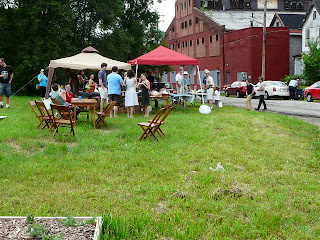






,+good+company,+good+beer+-+and+maybe+a+basketful+of+beekeeping+goodies.JPG)







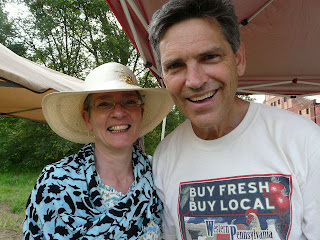

.JPG)





